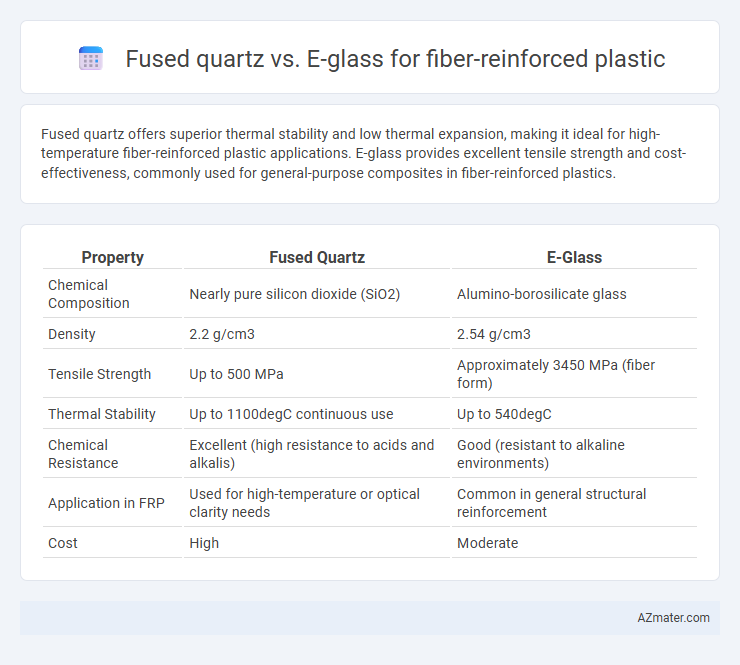Fused quartz offers superior thermal stability and low thermal expansion, making it ideal for high-temperature fiber-reinforced plastic applications. E-glass provides excellent tensile strength and cost-effectiveness, commonly used for general-purpose composites in fiber-reinforced plastics.
Table of Comparison
| Property | Fused Quartz | E-Glass |
|---|---|---|
| Chemical Composition | Nearly pure silicon dioxide (SiO2) | Alumino-borosilicate glass |
| Density | 2.2 g/cm3 | 2.54 g/cm3 |
| Tensile Strength | Up to 500 MPa | Approximately 3450 MPa (fiber form) |
| Thermal Stability | Up to 1100degC continuous use | Up to 540degC |
| Chemical Resistance | Excellent (high resistance to acids and alkalis) | Good (resistant to alkaline environments) |
| Application in FRP | Used for high-temperature or optical clarity needs | Common in general structural reinforcement |
| Cost | High | Moderate |
Overview of Fiber-Reinforced Plastics
Fiber-reinforced plastics (FRPs) combine a polymer matrix with high-strength fibers such as fused quartz or E-glass to enhance mechanical properties including tensile strength, stiffness, and thermal stability. Fused quartz fibers offer superior heat resistance and low thermal expansion, making them ideal for high-temperature and precision applications, while E-glass fibers provide cost-effective strength and good chemical resistance suitable for general structural uses. The choice between fused quartz and E-glass fibers directly affects the performance, durability, and application scope of FRP composites across industries like aerospace, automotive, and construction.
What is Fused Quartz?
Fused quartz is a highly pure, synthetic glass made by melting high-purity silica sand at extremely high temperatures, resulting in a material with exceptional thermal stability, low thermal expansion, and superior optical clarity. In fiber-reinforced plastics, fused quartz fibers offer improved mechanical strength, high resistance to thermal shock, and excellent electrical insulation properties compared to E-glass fibers. The superior chemical durability and higher melting point of fused quartz make it ideal for advanced composite applications requiring enhanced performance under extreme environmental conditions.
Understanding E-Glass Composition
E-glass, primarily composed of alumino-borosilicate glass with approximately 54-56% SiO2, 12-16% Al2O3, and 16-25% CaO and MgO, is engineered for fiber-reinforced plastic (FRP) to provide high tensile strength and excellent electrical insulation. Unlike fused quartz, which consists almost entirely of pure silica (SiO2), E-glass offers improved mechanical properties due to its tailored chemical composition, making it more cost-effective and widely used in FRP applications. The addition of alumina and calcium oxide enhances E-glass durability, chemical resistance, and fiber-matrix adhesion, optimizing composite performance in structural and marine environments.
Mechanical Properties Comparison
Fused quartz fibers exhibit superior tensile strength and higher modulus of elasticity compared to E-glass fibers, making them ideal for applications requiring enhanced mechanical performance in fiber-reinforced plastics. E-glass fibers offer good impact resistance and cost-effectiveness but have lower stiffness and tensile properties than fused quartz. The high thermal stability and low thermal expansion coefficient of fused quartz also contribute to improved structural integrity under mechanical stress.
Thermal Stability: Fused Quartz vs. E-Glass
Fused quartz exhibits superior thermal stability compared to E-glass, maintaining its structural integrity and low thermal expansion up to temperatures exceeding 1000degC. E-glass, commonly used as reinforcement in fiber-reinforced plastics, generally withstands thermal exposure up to approximately 550degC before degradation begins. The low coefficient of thermal expansion (CTE) of fused quartz significantly reduces thermal stress and microcracking in composites subjected to high-temperature environments, making it preferable for aerospace and high-performance industrial applications.
Chemical Resistance Differences
Fused quartz exhibits exceptional chemical resistance, maintaining stability against strong acids, alkalis, and solvents, making it ideal for harsh chemical environments in fiber-reinforced plastics. E-glass, while offering good resistance to water and alkalis, is more susceptible to attack by acidic or basic chemicals, which can degrade fiber strength over time. This chemical stability difference positions fused quartz fibers as superior for composites requiring long-term durability in aggressive chemical conditions.
Optical Transmission and Transparency
Fused quartz offers superior optical transmission and clarity with over 90% light transmittance across the UV to near-infrared spectrum, making it ideal for fiber-reinforced plastics in applications requiring minimal signal loss and high transparency. E-glass, while cost-effective and mechanically strong, exhibits lower optical clarity due to higher light scattering and absorption, typically transmitting around 80-85% in visible wavelengths. The inherent purity and low hydroxyl content of fused quartz significantly reduce optical attenuation, enhancing performance in high-precision optical fiber composites compared to standard E-glass fibers.
Price and Availability Analysis
Fused quartz offers superior thermal stability and purity but comes at a significantly higher cost and limited availability compared to E-glass, which is widely produced and more affordable for fiber-reinforced plastic applications. E-glass provides a cost-effective solution with abundant supply, making it the preferred choice for large-scale production despite lower performance in extreme environments. The price difference between fused quartz and E-glass can be substantial, influencing material selection based on budget constraints and required fiber properties.
Typical Applications in Industry
Fused quartz is primarily used in high-performance fiber-reinforced plastics for aerospace and semiconductor industries due to its exceptional thermal stability and low thermal expansion. E-glass fibers dominate the market in automotive, construction, and marine applications, offering cost-effective reinforcement with good mechanical properties and electrical insulation. The choice between fused quartz and E-glass hinges on application-specific demands for temperature resistance, strength, and budget constraints.
Choosing the Right Fiber for Your Project
Fused quartz fibers offer superior thermal stability and chemical resistance, making them ideal for high-temperature or corrosive environments in fiber-reinforced plastics. E-glass fibers provide excellent tensile strength and cost efficiency, widely used in structural applications requiring good mechanical performance at a lower price point. Selecting between fused quartz and E-glass depends on balancing project requirements for temperature tolerance, chemical exposure, and budget constraints.

Infographic: Fused quartz vs E-glass for Fiber-reinforced plastic
 azmater.com
azmater.com